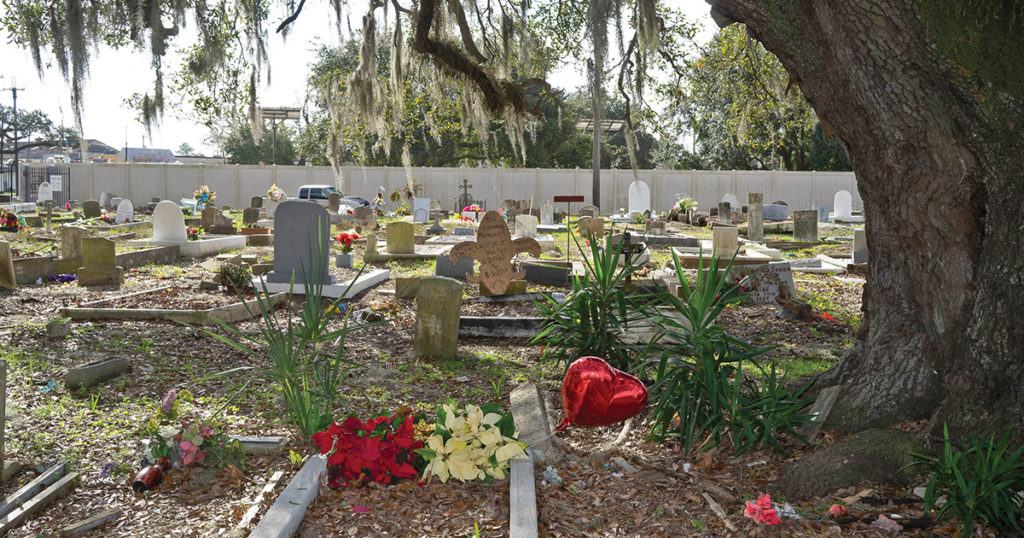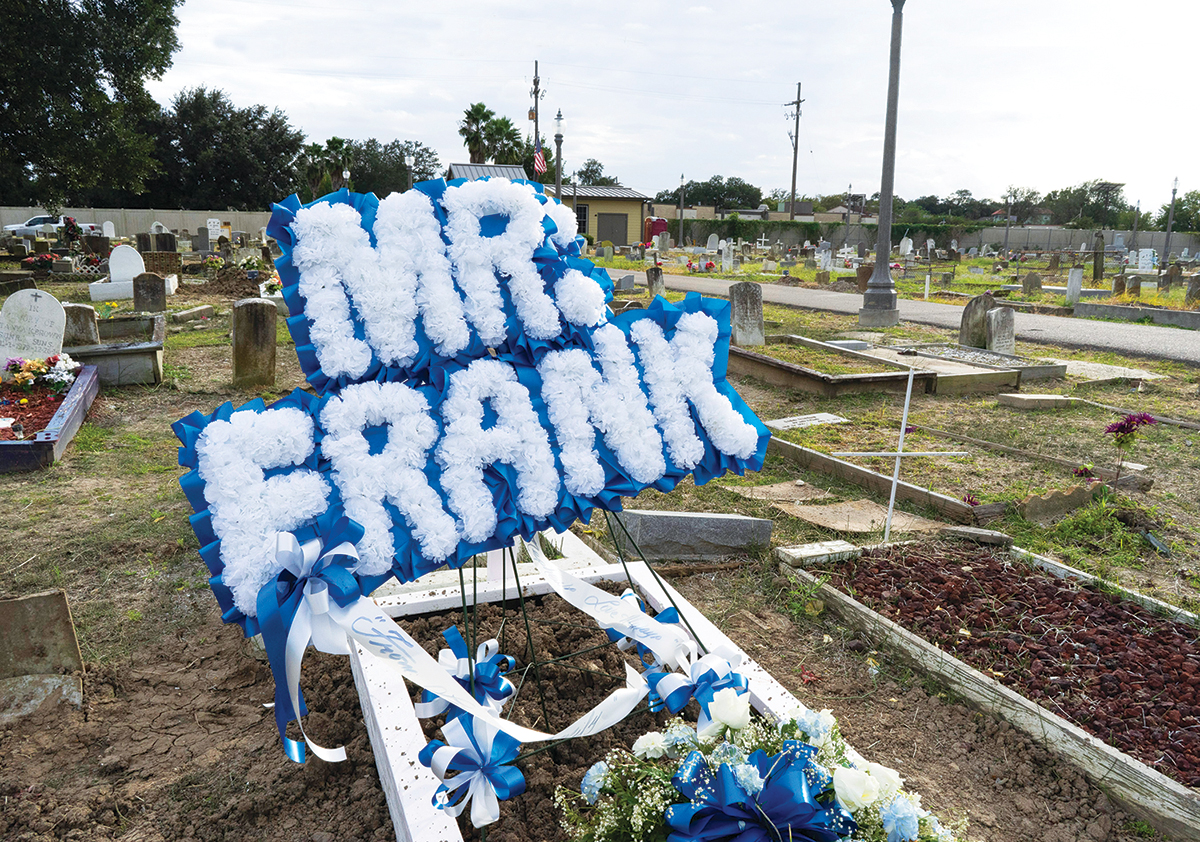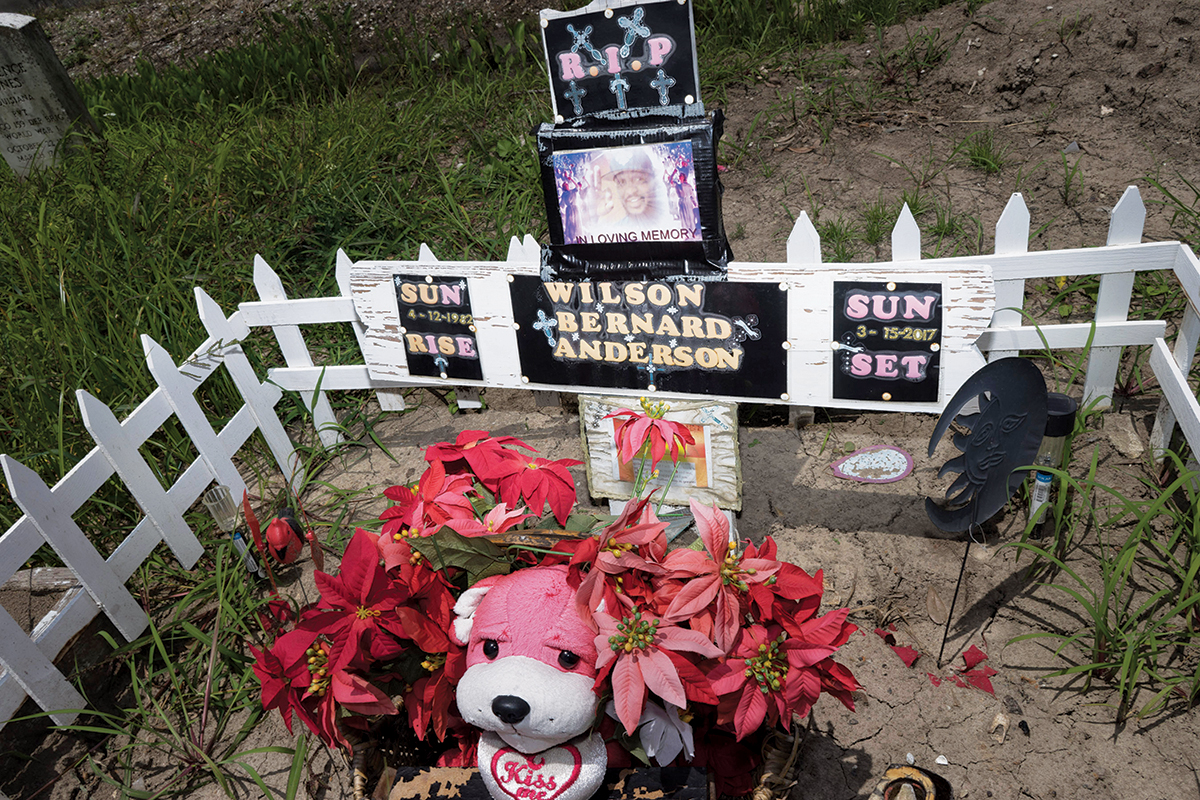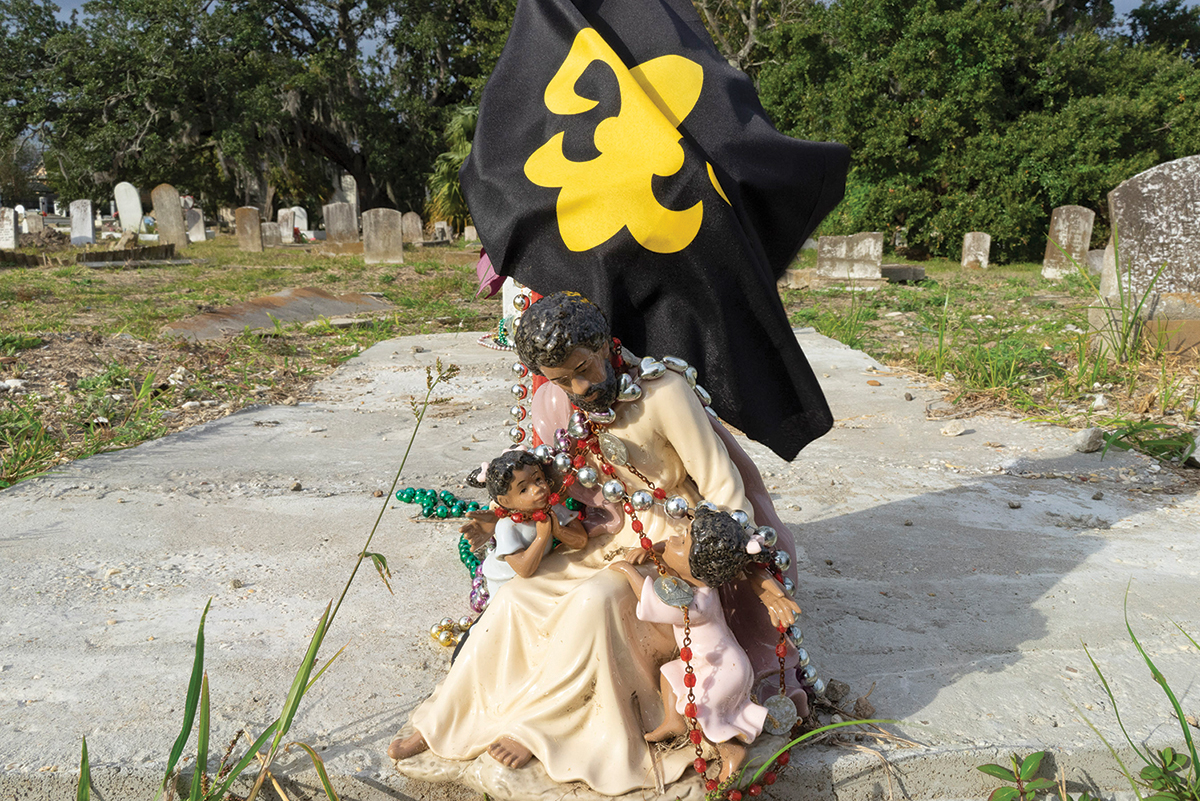New Orleans: Vanishing Graves
Holt Cemetery has been filled to capacity many times over; each gravesite has been used for dozens of burials

When Gaynell Brady goes to Holt Cemetery, a historically Black burial ground here in New Orleans, she doesn’t visit any particular grave. She winds her way slowly through the walled-off seven-acre lot, making a circuit of the graves along a narrow, paved path. There are thousands of gravesites in Holt, squeezed together in haphazard rows wherever space allows. Unlike in most New Orleans cemeteries, burials here are belowground, in shallow, unnumbered plots that flood with nearly every rain. Many sites are scrupulously well tended, freshly adorned with flowers and photographs; others would hardly be recognizable as graves were it not for the bones that occasionally surface out of the loosely packed dirt. Generations of Brady’s ancestors are buried in this place, though she doesn’t know where. All of their graves have been lost.
Brady is a genealogist, specializing in tracing the ancestries of Black families in New Orleans. Cemetery records and gravestones are central to her work. “Burials aren’t just a way of giving dignity to the dead,” she says. “They’re also a way of remembering, of etching these families’ stories into stone.” In Holt, though, memorials have no guarantee of permanence. According to Warren Ernest, who has been the primary gravedigger in the cemetery for 40 years, Holt is “one of the cheapest places in this world to bury a body.” For some of the city’s poorest residents, it is the only option, costing about 20 percent of the most affordable alternative. The cemetery has been filled to capacity many times over; each gravesite has been used for dozens of burials. Whenever a new burial needs to be made, Ernest digs up any grave that appears “untended.” If a family like Brady’s leaves the area for a brief period—as so many did after Hurricane Katrina in 2005—they may return to find that the graves of their ancestors have been dug up, with no documentation that they were ever there.
During the Covid-19 pandemic, this reuse of graves in Holt has accelerated dramatically. It has become the most-visited cemetery in New Orleans, as families try to protect the plots of their loved ones. Black people in New Orleans have accounted for roughly 77 percent of deaths from the virus, despite making up only 60 percent of the city’s population. Many of these victims have been buried in Holt; over the summer, the number of burials here roughly doubled.
Holt Cemetery was founded on the heels of another public health crisis, the yellow fever epidemic of 1878. The flow of ships in and out of New Orleans’s ports had always made it vulnerable to disease, and yellow fever had already decimated the city’s population many times, most notably in 1853, when tens of thousands are believed to have died. Early in the summer of 1878, as news spread of yellow fever’s return, the city’s wealthier residents fled in droves. Those who remained faced the brunt of the disease.
Black people, especially in low-income communities, were disproportionately affected. This was in part because of disparities in access to health care, but the high toll also had another insidious cause: a racist myth, propagated by white doctors, that Black people possessed a genetic immunity to the disease. This myth was originally used by slave owners as a defense of slavery; because Black people were immune to yellow fever, it was said, God had intended them to be slaves to carry out essential labor under dangerous conditions. In 1878, the myth became a justification for forcing Black people to perform essential labor while much of the rest of New Orleans remained safely quarantined. Locust Grove—the city’s original potter’s field—was soon overwhelmed with bodies to bury and declared full. In 1879, Holt Cemetery was established to take its place.
For the first 80 or so years of its existence, Holt was mostly used by the city coroner to bury unidentified or indigent people. Some were patients at local psychiatric hospitals whose bodies were unclaimed after their deaths. Buddy Bolden, the legendary jazz cornetist who spent the last decades of his life in treatment for schizophrenia at the Louisiana State Insane Asylum, was buried at the cemetery in an unmarked grave. Holt became an almost exclusively Black space in the 1960s, when the city moved the coroner’s burials elsewhere, leaving it to be used primarily by low-income Black families in the surrounding area. This shift marked the beginning of the period of municipal neglect that continues today.
“When the cemetery became a de facto segregated space, city services completely abandoned it,” explains Emily Ford, the city’s superintendent of cemeteries since late last year. “The disastrous conditions at Holt starting in that period were absolutely a product of racism,” she says. By the 1980s, conditions there had deteriorated so much that city officials decided it needed to be closed. But nothing ever happened.
Today, the city continues to provide almost no maintenance or oversight in Holt. City management keeps no formal records of the burials—despite being legally required to do so—and leaves it up to Warren Ernest to decide when a grave should be reused, based on his memory of how recently it was visited and how well tended it appears.
“I’m like their little spy,” Ernest says with a grim laugh. When he digs up an old grave, he seals any human remains he finds in garbage bags, then puts the bags back in the hole before making a new interment, to keep the bones separate. (Under state law, human remains cannot be moved from their original burial location without consent from next of kin. The law says nothing, however, about exhuming remains and putting them into garbage bags, as long as they stay put.)
Though Ernest has been working as a gravedigger at Holt since 1980, when he was in high school, he is no longer employed in any formal capacity, and receives no benefits or compensation from the city. He digs the graves with a shovel, sometimes in hundred-degree heat. Families pay him in cash. Ford views these informal employment practices as further evidence of the city’s longstanding neglect of the cemetery. “The story of Holt is in many ways a story of mistreatment of Black bodies,” she says, “from the people buried there to the men that do the digging.”

Brady became a genealogist after Hurricane Katrina, which devastated her community and took the life of her sister. “You bury that many people, you see your town, your history, your family destroyed, you’re gonna want to start documenting things,” she says. She has since dedicated herself to researching her ancestry. She has traced back eight generations on her mother’s side to Sally Robbins, who was born into slavery in Clinton, Louisiana, around 1810. Using census and burial records, Brady has followed the path of her family from Clinton to Bayou des Allemands in the early 1900s, and then to New Orleans in the 1920s, where Brady’s great-great-great-grandparents, the Reverend John Meyers and his wife, Sarah, founded the Second Nazareth Baptist Church. For the past 90 years, that church has served as her family’s home base. Whenever a relative died, the funeral would be held at the church, usually followed by a burial in Holt. Her family owned the church until earlier this year, when they could no longer afford to keep it.
The process of unearthing the names and stories of her ancestors has taken Brady all over Louisiana. The difficulty of doing her research has been compounded by the loss of her family’s graves. She views this loss as part of a large-scale process, saying, “In a place like Holt, you see how our people get erased. Looking at a cemetery, you can usually tell if it’s Black people or white people buried there. And it hurts.” Since she does not know where any of her relatives are buried, Brady chooses to treat the entire cemetery as their memorial. She talks to her ancestors when she visits, addressing them in turn. Sometimes she tells them about her family and her work, and she thanks them for all they did to make her life possible. Most often, though, she recites her family history, repeating the stories of her ancestors to their nameless graves, as if to sear them into memory.
Brady speaks of her ancestors with such affection and admiration that it seems as if she has known them personally for her entire life. She has special reverence for the women, who often served as matriarchs and caregivers for their communities. Her great-great-grandmother Belle Jefferson—Ma Belle, Brady calls her—was one such figure, caring for children and mothers in her neighborhood when the men left for World War II. “She was a soft place for anyone in hard times to land,” Brady says. Though Brady never met Ma Belle, she is an inspiration in all things, from raising children (Brady has four) to doing her genealogical research. One day, Brady says, when she has saved up enough money, she will buy headstones in Holt for every one of her ancestors, starting with Ma Belle.
In addition to helping families trace their histories, Brady spends much of her time leading genealogy workshops at local schools. Her dream is to inspire a new generation of Black genealogists who will take up the work of preserving their family histories. Last year, she helped to establish the Louisiana chapter of the Afro-American Historical and Genealogical Society, of which she is the vice president. Through this organization, Brady hopes to provide resources for future documentation and preservation projects in Holt and other cemeteries. The group also hosts events aimed at teaching people how to maintain their families’ graves and protect them from reuse.
As crucial as cemeteries are for genealogists, though, Brady believes their greatest value lies in their power to heal. It was the process of grieving for her sister that first showed Brady the importance of cemeteries.
“Her body laid in the house in the Lower Ninth Ward for months before they found her,” Brady says. “It wasn’t until I finally went back to where that house had been, and made a garden there in her memory, that I got some closure. I felt her there with me, and I felt peace. That’s why we need places like Holt, so that our people can deal with traumas, with personal and generational and historical traumas. Just being in that place, it helps. We need this place of healing, this place of closure, this place of memory.”

The increasingly rapid turnover of graves in Holt raises the question of how a grave might be deemed “untended” and eligible for reuse. This question is highly subjective, especially because of the abundance of improvised or handmade memorials in the cemetery. Many graves are decorated with PVC pipes or delicate plastic pinwheels, and others feature painted-over street signs half buried in the dirt. Some city officials have suggested that the abundance of grave decorations contributes to the difficulty of maintaining Holt. “Part of the reason it’s hard to hire people to take care of it,” says Emily Ford, “is that outsiders often confuse legitimate grave decorations for trash.” Those who make such misinterpretations ignore the significance and symbolism of these memorials, many of which are rooted in centuries of Black burial practices.
In the early 1980s, a man named Arthur Raymond Smith began decorating graves at Holt. Then in his early 50s, homeless and mourning the death of his mother, Smith regularly started riding the bus out to the cemetery. He would bring along a grocery cart filled with the varied materials of his art, including glass bottles, car tires, and lawn chairs, all salvaged from the streets of the city.
For at least a decade, Smith dedicated himself to fashioning elaborate grave decorations as a way to honor and memorialize everyone buried in Holt. His work became more than just a shrine, though. It also served to protect otherwise untended graves from being reused. By 1997, city workers, deeming Smith’s work an unsightly nuisance, forced him to remove the bulk of his ever-expanding art installation. Grave decoration remained his passion, though, and he continued to create and maintain smaller memorials in the cemetery.
Smith’s creations are part of a long tradition of Black vernacular and visionary art, especially in the South. Much of this tradition centers on the remembrance of the dead, and examples of these artistic memorialization practices, even beyond Smith’s, abound at Holt. Some of these practices are explicitly Christian, while others are tied to Voodoo beliefs; some are descended from African traditions and have existed in this country since the start of the transatlantic slave trade.
A common thread is an emphasis on the symbolic protection of the gravesite. Perhaps the most ubiquitous feature of graves at Holt is an abundance of color and brightness. Many of the graves are dressed with brilliantly reflective plastic foils or polished metal objects. One likely origin of the use of reflective surfaces is the Kongo people of West Africa, who often used beetle wings or kaolin clay for reflective grave dressings. This brightness can signify the glory of heaven, the shining memory of those who have died, and a protective force for the graves they decorate. PVC pipes or other hollow conduits in Holt are often used as symbols through which messages to the dead may pass—another custom with origins in Kongo belief.
Other common decorations include round objects such as tires and pinwheels known as God’s wheels—which represent continuity amid change; animal statues and stuffed animals that watch over the graves; thrones or chairs, the earthly manifestations of the seats reserved for the dead in heaven; whitewashed rocks, to mark sanctified ground; “experienced objects,” such as the tools of one’s work; pottery shards, alluding to the world of the dead, where broken things are made whole; inverted bottles, which evoke the “other side” of life; and fences, which seal the protective powers of the other symbolic objects placed within.

As with nearly everything in New Orleans, the history of Holt is typically split into two periods: before Hurricane Katrina and after. It was generally thought that the cemetery would be closed forever after the hurricane—and the negligent government response to it—left the city in ruins. Holt was severely flooded. Hundreds of graves were destroyed. Once the waters receded, human remains lay scattered throughout the burial ground. Many of the families displaced by Katrina found, when they eventually returned, no trace of their ancestors’ graves.
In the wake of the devastation, the New Orleans Office of Municipal Cemeteries all but disappeared. Before Katrina, the office had nine employees, as well as a team of landscapers and gravediggers, including Warren Ernest. Most of those people never came back after the storm. A few gravediggers like Ernest kept up their work, despite no longer being employed by the city. In 2013 and 2014, facing pressure from local residents, New Orleans under Mayor Mitch Landrieu undertook a $450,000 renovation of Holt, which involved adding new lights and paving the cemetery path. But conditions continued to be a source of outrage and despair for the community. In December 2019, acknowledging the need for more extensive improvements at Holt, Mayor LaToya Cantrell appointed Ford as superintendent of cemeteries to address the problems in the city’s graveyards. Nobody had occupied the position for 15 years.
Ford, who is white, has long been involved in advocacy and maintenance efforts on behalf of Holt. She has good relationships with many members of the surrounding community, including Brady, who describes Ford as “the best possible person for that job.” From the start, Ford knew that Holt would have to be a focus of her attention. “We have a lot of work to do to gain back the trust of folks that have family buried there,” she says. Alongside Ryan Gray, a professor of anthropology at the University of New Orleans, Ford is working to create an oral history program to document the stories of people buried in the cemetery. Her ultimate goal is to help create a public database of burials there, so that some families, at least, might eventually locate their lost plots. Ford is adamant that the city should provide the labor and funds to preserve Holt, but she is also wary of making top-down decisions that would affect the community.
“What I really want is to establish a sort of tomb-owners’ association of families,” she says. “I want there to be a community group that can decide what’s best for them, and that can be a pain in my ass to hold me accountable.”
Ultimately, Ford believes, the city will need to open a new cemetery and close Holt if it’s going to preserve it. She held this view even before the the influx of bodies as a result of the pandemic. Early this summer, Mayor Cantrell unveiled a proposal to build a new cemetery in the Voscoville neighborhood, a few miles east of Holt. During a virtual town hall with the area’s residents—many of whom opposed the proposal, fearing it would lower property values—Mayor Cantrell said, “In order to deal with Holt, I got to cut it off. And I got to close it down to invest what’s necessary to deal with our dead. Literally when you go to Holt in some cases it’s like you’re walking on the remains of our people. It’s unacceptable.”
The proposal to close Holt is controversial. Some community members—like Michael Sharon, who often visits the graves of his family members there—fear that closure will deprive people of their only affordable burial option and make it impossible for those with ancestors in Holt to be buried alongside them. Sharon says, “I get that things are bad here, and the conditions are a real source of shame. It hurts. But I want to be buried with my people.” Given that the city has been talking about closing Holt since the late 1980s, Sharon is skeptical that it will ever happen. Brady argues that the best solution would be to close it off to most new burials, allowing only those who have family members already in the cemetery to be buried there. “It would make it harder for people who can’t afford burials in other places,” she acknowledges. “But if we can create an alternative for them, we got to close it. It can’t be the meaningful place it’s meant to be if it’s this crowded with bodies and if graves are being lost.”
It’s around noon on a scorching Tuesday in July, when much of New Orleans sits tucked away in air-conditioned rooms, and Warren Ernest is digging a grave. The soil is dry and loose, and with every scoop of the shovel, more slides down into the hole. Behind him stands a quiet huddle of mourners, men in heavy suits and women in long, dark dresses. They watch as he cuts deeper into the earth, and they murmur prayers and reminiscences about the man they are about to bury. He was their father, their brother, their friend. Once the casket has been lowered and Ernest has finished filling in the hole, he plants his shovel in the ground and steps aside to towel off his face. The mourners draw closer. Some of the men kneel down, tossing fistfuls of dirt onto the grave and clapping their hands clean. A woman sets a spray of blue plastic flowers at the foot of the plot. The group soon disperses.
Ernest has moved to a sliver of shade near the gate of the cemetery. A small electric fan churns feebly beside him. He watches the funeral-goers leaving. A few of them pause under the tangled Spanish moss that hangs from the ancient oak near the grave. “Those folks’ll be back,” Ernest says. “They’ll keep that plot.” He leans against the shed and closes his eyes. In a few minutes, there will be another grave to dig.

